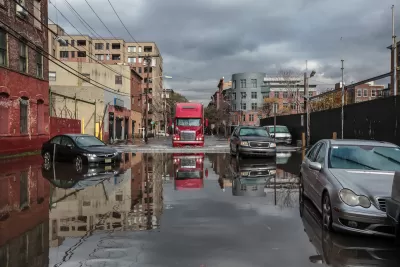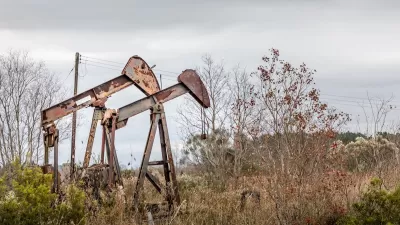Communities of color make up the majority of people harmed by pollution, as well as heat and flooding, says the study, which is New York City’s first comprehensive survey of environmental injustices.

A New York City report released last week by the mayor’s office found that nearly 50 percent of all New Yorkers live in areas disproportionately burdened by pollution, and the majority of those people live in communities of color. It marks the city’s first official comprehensive survey of environmental inequalities, reports Aliya Uteuova for the Guardian.
Researchers found that two-thirds of the people in historically red-lined areas, which are still to this day predominantly Black and Latino, live in areas the city calls environmental justice (EJ) areas.
These areas tend to have less tree cover and fewer parks (leading to hotter temperatures), greater vulnerability to stormwater flooding, and higher concentrations of highways, industrial power plants, and waste-water processing facilities nearby
The report’s findings are likely not a surprise to environmental justice advocates or the Black and Latino communities, who have long been sounding the alarm of poor health and economic outcomes for these neighborhoods. However, Peggy Shepard of We Act for Environmental Justice, who was involved in the report, told the Guardian that having these results officially documented by the city will ensure that environmental justice stays on New York City’s agenda. The next stage, she said, will be developing a citywide plan to address it.
FULL STORY: Pollution burdens nearly half of New York and communities of color most harmed – report

Alabama: Trump Terminates Settlements for Black Communities Harmed By Raw Sewage
Trump deemed the landmark civil rights agreement “illegal DEI and environmental justice policy.”

Study: Maui’s Plan to Convert Vacation Rentals to Long-Term Housing Could Cause Nearly $1 Billion Economic Loss
The plan would reduce visitor accommodation by 25% resulting in 1,900 jobs lost.

Why Should We Subsidize Public Transportation?
Many public transit agencies face financial stress due to rising costs, declining fare revenue, and declining subsidies. Transit advocates must provide a strong business case for increasing public transit funding.

Paris Bike Boom Leads to Steep Drop in Air Pollution
The French city’s air quality has improved dramatically in the past 20 years, coinciding with a growth in cycling.

Why Housing Costs More to Build in California Than in Texas
Hard costs like labor and materials combined with ‘soft’ costs such as permitting make building in the San Francisco Bay Area almost three times as costly as in Texas cities.

San Diego County Sees a Rise in Urban Coyotes
San Diego County experiences a rise in urban coyotes, as sightings become prevalent throughout its urban neighbourhoods and surrounding areas.
Urban Design for Planners 1: Software Tools
This six-course series explores essential urban design concepts using open source software and equips planners with the tools they need to participate fully in the urban design process.
Planning for Universal Design
Learn the tools for implementing Universal Design in planning regulations.
Smith Gee Studio
Alamo Area Metropolitan Planning Organization
City of Santa Clarita
Institute for Housing and Urban Development Studies (IHS)
City of Grandview
Harvard GSD Executive Education
Toledo-Lucas County Plan Commissions
Salt Lake City
NYU Wagner Graduate School of Public Service



























